Related Research Articles

The steamship Virginia V is one of two last operational examples of Puget Sound Mosquito Fleet steamers. She was once part of a large fleet of small passenger and freight carrying ships that linked the islands and ports of Puget Sound in Washington state in the late 19th and early 20th centuries. She is a Seattle landmark and a National Historic Landmark.
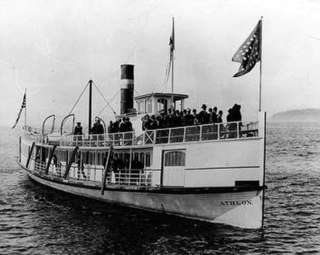
Athlon was a typical passenger steamboat of the Puget Sound Mosquito Fleet.

The Hunt Brothers were the owners of a steamboat business that ran on Puget Sound as part of the Puget Sound Mosquito Fleet. Five of the seven Hunt children became owners, engineers and masters of steamboats, these were Emmett E., Arthur M., Arda R., Lloyd.B., and Forest M. Hunt.

The steamboat Defiance operated in the early 1900s as part of the Puget Sound Mosquito Fleet. In later years this vessel was called Kingston.
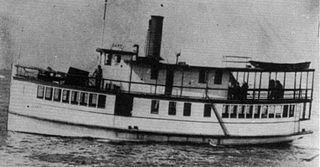
The steamboat Dart operated in the early 1900s as part of the Puget Sound Mosquito Fleet.

The steamboat Monticello (2) operated in the early 1900s as part of the Puget Sound Mosquito Fleet. The vessel went through several reconstructions and remained in service until 1962, when she was lost in Alaska waters. Her later names were Penaco and Sea Venture. (This Puget Sound steamer should not be confused with the smaller Monticello, which also ran on Puget Sound, but was built in 1895 for Captain Z.J. Hatch of the Monticello Steamship Company.

The steamboat S.G.Simpson operated in the early 1900s as part of the Puget Sound Mosquito Fleet. This vessel was later renamed E.G. English.

The steamboat Dix operated from 1904 to 1906 as part of the Puget Sound Mosquito Fleet. She was sunk in a collision which remains one of the most serious transportation accidents in the state of Washington to this day.

The steamboat Rosalie operated from 1893 to 1918 as part of the Puget Sound Mosquito Fleet, also operating out of Victoria, B.C. In 1898, Rosalie went north with many other Puget Sound steamboats to join the Klondike Gold Rush.

Burton was a steamboat built in 1905 in Tacoma, Washington and which was in service on Puget Sound until 1924.

Crest was a wooden steamboat that operated on Puget Sound in the early 1900s. Following a sale of the vessel in May, 1912, this boat was known as Bay Island.

T.W. Lake was a steamboat that ran on Puget Sound in the early 1900s. This vessel was lost with all hands on December 5, 1923 in one of the worst disasters of the Puget Sound Mosquito Fleet.
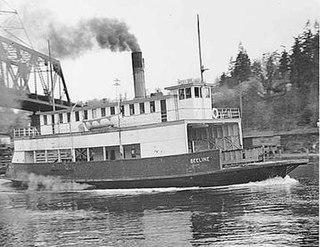
Florence K was a steamboat that was operated on Puget Sound from 1903. This vessel was later renamed Gloria and was rebuilt as a steam ferry and renamed Beeline.

Inland Flyer was a passenger steamboat that ran on Puget Sound from 1898 to 1916. From 1910 to 1916 this vessel was known as the Mohawk. The vessel is notable as the first steamer on Puget Sound to use oil fuel. Inland Flyer was one of the most famous vessels of the time on Puget Sound.

Sioux was a steamship which was operated on Puget Sound and the Strait of Juan de Fuca from 1912 to 1941. From 1924 to 1941, following reconstruction, the vessel operated as an auto ferry under the name Olympic. During the Second World War (1941-1945) this vessel was taken under the control of the U.S. Army and renamed the Franklin R. Leisenburg. The Liesenburg served as a ferry in the Panama Canal area under Army control, and then was sold to a firm which ran the vessel on the Surinam river in South America.
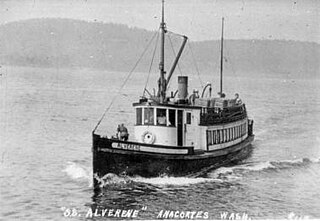
Alverene was a gasoline launch built in 1912 which operated on northern Puget Sound and in the San Juan Islands.

Concordia was a steamboat that ran on Puget Sound from 1930 to 1976. Although later converted to diesel power, Concordia was the last inland commercial steamboat ever built on either Puget Sound or the Columbia river.

Speeder was a motor launch built in 1908 which served on Puget Sound and in the San Juan Islands. From 1908 to 1922 this vessel was named Bainbridge.

Falcon was a 26 registered ton gasoline-powered launch built in Bellingham, Washington in 1909. She operated in Puget Sound and nearby regions, and also on Lake Washington during the first part of the 1900s. The wreck of this vessel has been discovered in Lake Washington not far from Kirkland and is in good condition under 190 feet (58 m) of water. This vessel should not be confused with the steam tug Falcon built in Tacoma, Washington in 1902.
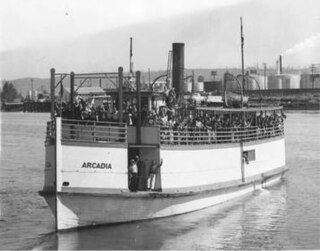
The steamboat Arcadia, built in 1929, was one of the last commercial steamboats placed into service on Puget Sound. The vessel later served as a prison tender under the name J.E. Overlade, and after that, as Virginia VI, as an excursion vessel.
References
- Findlay, Jean Cammon and Paterson, Robin, Mosquito Fleet of Southern Puget Sound, (2008) Arcadia Publishing ISBN 0-7385-5607-6
- Newell, Gordon, ed. H.W. McCurdy Maritime History of the Pacific Northwest, Superior Publishing 1966.
- U.S. Dept. of Commerce, Bureau of Corporation, Report of the Commissioner of Corporations on Transportation by Water in the United States, (1909) (gives fleet compositions and corporate details, Pacific Coast inland companies start on page 236).